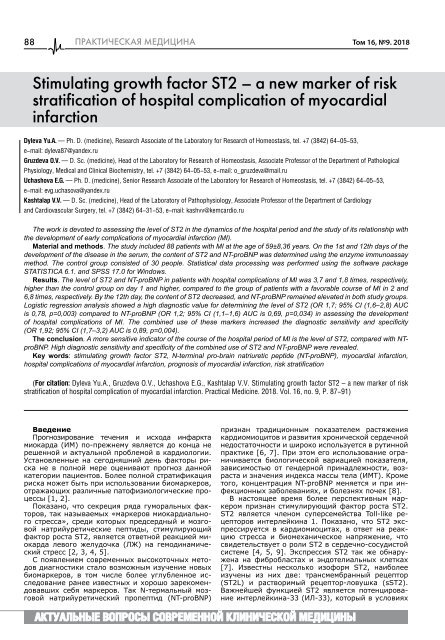9_Актуальные вопросы современной клинической медицины с обл
You also want an ePaper? Increase the reach of your titles
YUMPU automatically turns print PDFs into web optimized ePapers that Google loves.
88 ПРАКТИЧЕСКАЯ МЕДИЦИНА<br />
Том 16, №9. 2018<br />
Stimulating growth factor ST2 – a new marker of risk<br />
stratification of hospital complication of myocardial<br />
infarction<br />
Dyleva Yu.A. — Ph. D. (medicine), Research Associate of the Laboratory for Research of Homeostasis, tel. +7 (3842) 64-05-53,<br />
e-mail: dyleva87@yandex.ru<br />
Gruzdeva O.V. — D. Sc. (medicine), Head of the Laboratory for Research of Homeostasis, Associate Professor of the Department of Pathological<br />
Physiology, Medical and Clinical Biochemistry, tel. +7 (3842) 64-05-53, e-mail: o_gruzdeva@mail.ru<br />
Uchashova E.G. — Ph. D. (medicine), Senior Research Associate of the Laboratory for Research of Homeostasis, tel. +7 (3842) 64-05-53,<br />
e-mail: evg.uchasova@yandex.ru<br />
Kashtalap V.V. — D. Sc. (medicine), Head of the Laboratory of Pathophysiology, Associate Professor of the Department of Cardiology<br />
and Cardiovascular Surgery, tel. +7 (3842) 64-31-53, e-mail: kashvv@kemcardio.ru<br />
The work is devoted to assessing the level of ST2 in the dynamics of the hospital period and the study of its relationship with<br />
the development of early complications of myocardial infarction (MI).<br />
Material and methods. The study included 88 patients with MI at the age of 59±8,36 years. On the 1st and 12th days of the<br />
development of the disease in the serum, the content of ST2 and NT-proBNP was determined using the enzyme immunoassay<br />
method. The control group consisted of 30 people. Statistical data processing was performed using the software package<br />
STATISTICA 6.1. and SPSS 17.0 for Windows.<br />
Results. The level of ST2 and NT-proBNP in patients with hospital complications of MI was 3,7 and 1,8 times, respectively,<br />
higher than the control group on day 1 and higher, compared to the group of patients with a favorable course of MI in 2 and<br />
6,8 times, respectively. By the 12th day, the content of ST2 decreased, and NT-proBNP remained elevated in both study groups.<br />
Logistic regression analysis showed a high diagnostic value for determining the level of ST2 (OR 1,7; 95% CI (1,6–2,8) AUC<br />
is 0,78, p=0,003) compared to NT-proBNP (OR 1,2; 95% CI (1,1–1,6) AUC is 0,69, p=0,034) in assessing the development<br />
of hospital complications of MI. The combined use of these markers increased the diagnostic sensitivity and specificity<br />
(OR 1,92; 95% CI (1,7–3,2) AUC is 0,89, p=0,004).<br />
The conclusion. A more sensitive indicator of the course of the hospital period of MI is the level of ST2, compared with NTproBNP.<br />
High diagnostic sensitivity and specificity of the combined use of ST2 and NT-proBNP were revealed.<br />
Key words: stimulating growth factor ST2, N-terminal pro-brain natriuretic peptide (NT-proBNP), myocardial infarction,<br />
hospital complications of myocardial infarction, prognosis of myocardial infarction, risk stratification<br />
(For citation: Dyleva Yu.A., Gruzdeva O.V., Uchashova E.G., Kashtalap V.V. Stimulating growth factor ST2 – a new marker of risk<br />
stratification of hospital complication of myocardial infarction. Practical Medicine. 2018. Vol. 16, no. 9, P. 87-91)<br />
Введение<br />
Прогнозирование течения и и<strong>с</strong>хода инфаркта<br />
миокарда (ИМ) по-прежнему являет<strong>с</strong>я до конца не<br />
решенной и актуальной пр<strong>обл</strong>емой в кардиологии.<br />
У<strong>с</strong>тановленные на <strong>с</strong>егодняшний день факторы ри<strong>с</strong>ка<br />
не в полной мере оценивают прогноз данной<br />
категории пациентов. Более полной <strong>с</strong>тратификация<br />
ри<strong>с</strong>ка может быть при и<strong>с</strong>пользовании биомаркеров,<br />
отражающих различные патофизиологиче<strong>с</strong>кие проце<strong>с</strong><strong>с</strong>ы<br />
[1, 2].<br />
Показано, что <strong>с</strong>екреция ряда гуморальных факторов,<br />
так называемых «маркеров миокардиального<br />
<strong>с</strong>тре<strong>с</strong><strong>с</strong>а», <strong>с</strong>реди которых пред<strong>с</strong>ердный и мозговой<br />
натрийуретиче<strong>с</strong>кие пептиды, <strong>с</strong>тимулирующий<br />
фактор ро<strong>с</strong>та ST2, являет<strong>с</strong>я ответной реакцией миокарда<br />
левого желудочка (ЛЖ) на гемодинамиче<strong>с</strong>кий<br />
<strong>с</strong>тре<strong>с</strong><strong>с</strong> [2, 3, 4, 5].<br />
С появлением <strong>с</strong>овременных вы<strong>с</strong>окоточных методов<br />
диагно<strong>с</strong>тики <strong>с</strong>тало возможным изучение новых<br />
биомаркеров, в том чи<strong>с</strong>ле более углубленное и<strong>с</strong><strong>с</strong>ледование<br />
ранее изве<strong>с</strong>тных и хорошо зарекомендовавших<br />
<strong>с</strong>ебя маркеров. Так N-термальный мозговой<br />
натрийуретиче<strong>с</strong>кий пропептид (NT-proBNP)<br />
признан традиционным показателем ра<strong>с</strong>тяжения<br />
кардиомиоцитов и развития хрониче<strong>с</strong>кой <strong>с</strong>ердечной<br />
недо<strong>с</strong>таточно<strong>с</strong>ти и широко и<strong>с</strong>пользует<strong>с</strong>я в рутинной<br />
практике [6, 7]. При этом его и<strong>с</strong>пользование ограничивает<strong>с</strong>я<br />
биологиче<strong>с</strong>кой вариацией показателя,<br />
зави<strong>с</strong>имо<strong>с</strong>тью от гендерной принадлежно<strong>с</strong>ти, возра<strong>с</strong>та<br />
и значения индек<strong>с</strong>а ма<strong>с</strong><strong>с</strong>ы тела (ИМТ). Кроме<br />
того, концентрация NT-proBNP меняет<strong>с</strong>я и при инфекционных<br />
заболеваниях, и болезнях почек [8].<br />
В на<strong>с</strong>тоящее время более пер<strong>с</strong>пективным маркером<br />
признан <strong>с</strong>тимулирующий фактор ро<strong>с</strong>та ST2.<br />
ST2 являет<strong>с</strong>я членом <strong>с</strong>упер<strong>с</strong>емей<strong>с</strong>тва Toll-like рецепторов<br />
интерлейкина 1. Показано, что ST2 эк<strong>с</strong>пре<strong>с</strong><strong>с</strong>ирует<strong>с</strong>я<br />
в кардиомиоцитах, в ответ на реакцию<br />
<strong>с</strong>тре<strong>с</strong><strong>с</strong>а и биомеханиче<strong>с</strong>кое напряжение, что<br />
<strong>с</strong>видетель<strong>с</strong>твует о роли ST2 в <strong>с</strong>ердечно-<strong>с</strong>о<strong>с</strong>уди<strong>с</strong>той<br />
<strong>с</strong>и<strong>с</strong>теме [4, 5, 9]. Эк<strong>с</strong>пре<strong>с</strong><strong>с</strong>ия ST2 так же обнаружена<br />
на фибр<strong>обл</strong>а<strong>с</strong>тах и эндотелиальных клетках<br />
[7]. Изве<strong>с</strong>тны не<strong>с</strong>колько изоформ ST2, наиболее<br />
изучены из них две: тран<strong>с</strong>мембранный рецептор<br />
(ST2L) и ра<strong>с</strong>творимый рецептор-ловушка (sST2).<br />
Важнейшей функцией ST2 являет<strong>с</strong>я потенцирование<br />
интерлейкина-33 (ИЛ-33), который в у<strong>с</strong>ловиях<br />
<strong>Актуальные</strong> <strong>вопро<strong>с</strong>ы</strong> <strong>с</strong>овременной клиниче<strong>с</strong>кой <strong>медицины</strong>

















